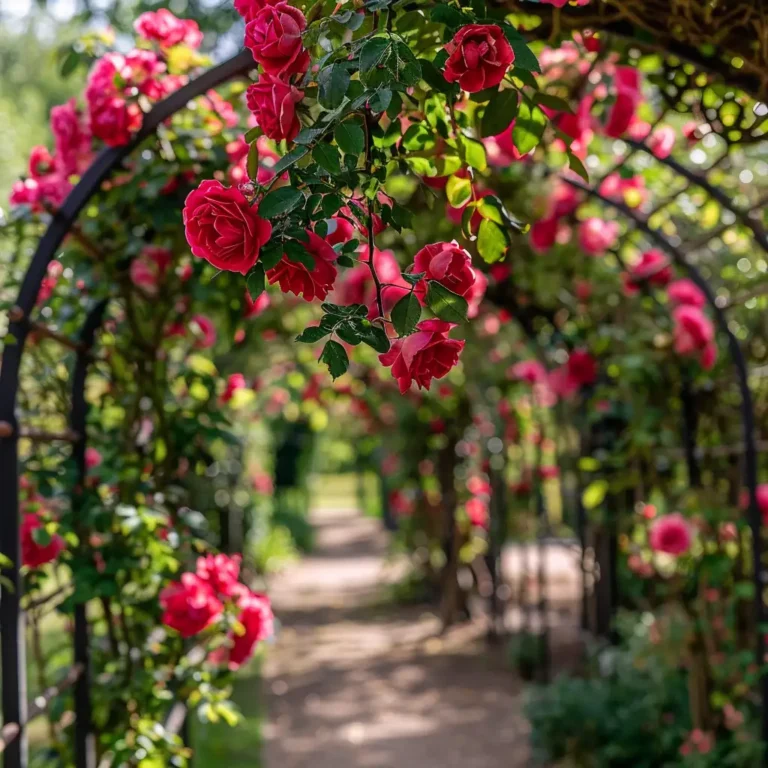The Crimson Glory Rose is a timeless beauty in the world of roses. With its deep velvety crimson petals and strong damask fragrance, it has captured the hearts of gardeners and rose enthusiasts alike. This article delves into the history, botanical description, cultivation, and various uses of this exquisite rose, providing a comprehensive guide for anyone interested in growing it.
History and Origin
The Crimson Glory Rose was introduced in 1935 by the renowned German rose breeder Wilhelm Kordes. This hybrid tea rose quickly gained popularity, winning numerous awards for its stunning blooms and intoxicating fragrance. Its introduction marked a significant milestone in the breeding of fragrant, hardy roses, and it remains a beloved variety to this day.
For more detailed information on the history and origin of roses, the American Rose Society provides extensive resources and historical insights.
Botanical Description
Classification
- Family: Rosaceae
- Genus: Rosa
- Species: Rosa ‘Crimson Glory’
Morphology
The Crimson Glory Rose is a climbing hybrid tea rose with large, double blooms that can reach up to 6 inches across. The flowers are a deep crimson color, often tinged with shades of purple. The leaves are dark green, providing a striking contrast to the vibrant blooms.
Growth Habits
This rose variety is known for its climbing nature, typically growing to a height of 5-7 feet. It thrives in full sun and well-drained soil, making it an excellent choice for trellises and arbors.
For a comprehensive guide on different rose varieties and their characteristics, visit the Royal Horticultural Society.
Planting Crimson Glory Rose
Ideal Planting Conditions
- Soil Type: Well-drained, loamy soil
- pH Level: Slightly acidic to neutral (6.0-7.0)
- Sunlight: Full sun (at least 6 hours per day)
Planting Guide
- Choose a location with good air circulation and sunlight.
- Dig a hole twice the width of the root ball and just as deep.
- Mix compost into the soil to improve fertility.
- Place the rose in the hole, spread the roots, and fill with soil.
- Water thoroughly to settle the soil around the roots.
Care and Maintenance
Watering Needs
- Keep the soil consistently moist but not waterlogged.
- Water at the base of the plant to avoid wetting the foliage.
Fertilization
- Use a balanced rose fertilizer or organic compost.
- Apply fertilizer in early spring and mid-summer for optimal growth.
Pruning Techniques
- Prune in late winter or early spring before new growth begins.
- Remove dead or diseased wood and thin out crowded branches.
- Shape the plant to encourage air circulation and sunlight penetration.
Pests and Diseases
Common Pests
- Aphids
- Spider mites
- Rose slugs
Management
- Use insecticidal soap or neem oil for pest control.
- Introduce beneficial insects like ladybugs to naturally reduce pest populations.
Disease Identification and Treatment
- Black Spot: Remove affected leaves and apply fungicide.
- Powdery Mildew: Increase air circulation and apply fungicidal spray.
- Rust: Prune affected areas and use a suitable fungicide.
Flowering and Fragrance
The Crimson Glory Rose blooms profusely in early summer, with occasional blooms throughout the season. The flowers are renowned for their strong, damask scent, making them a favorite for cutting gardens and floral arrangements.
Uses in Landscaping
Landscape Design Ideas
- Perfect for trellises, arbors, and pergolas
- Use as a focal point in garden beds or borders
- Combine with other fragrant plants for a sensory garden
Companion Planting
- Lavender
- Salvia
- Catmint
Use in Bouquets
- Ideal for cutting and arranging due to its large, fragrant blooms
- Combine with greenery and other flowers for stunning floral displays
Benefits and Drawbacks
Advantages
- Strong fragrance and vibrant color
- Long blooming season
- Suitable for various garden designs
Challenges
- Susceptible to common rose pests and diseases
- Requires regular maintenance and care
FAQs
How to propagate Crimson Glory Rose?
Propagation can be done through cuttings or grafting. Take cuttings from healthy, non-flowering stems and root them in a well-draining potting mix.
What are the best conditions for Crimson Glory Rose to thrive?
Crimson Glory Roses thrive in full sun and well-drained, slightly acidic soil. Regular watering and fertilization are essential for healthy growth.
How to deal with common pests on Crimson Glory Rose?
Use insecticidal soap or neem oil to control pests like aphids and spider mites. Introducing beneficial insects like ladybugs can also help reduce pest populations.
Can Crimson Glory Rose be grown in containers?
Yes, Crimson Glory Roses can be grown in large containers with adequate drainage and regular care.
How to enhance the fragrance of Crimson Glory Rose?
Plant in a sunny location and ensure proper watering and fertilization to enhance the natural fragrance of the blooms.
In conclusion, the Crimson Glory Rose is a stunning and fragrant addition to any garden. By following the proper planting and care guidelines, you can enjoy its beautiful blooms and captivating scent throughout the growing season.

